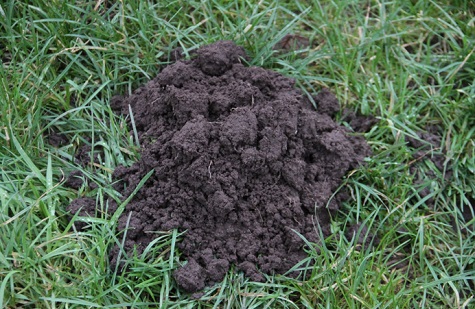Last week a friend of mine called to say he had a problem with moles in his garden and would I come and have a look to see what could be done to eradicate damage being caused?
It is usually at this time of year that we do indeed see the start of mole activities, with mole hills popping up everywhere. In many natural environments these are not really a problem, however when mole hills start appearing on fine lawns and sport pitches, they can pose an issue.
European moles are found in the UK and across Europe. They are related to shrew-moles, desmans and other small insectivores. Our moles are one of nine species of mole, found primarily in Europe and western Asia.
European or Common Moles have a fat, long body covered in dark grey or black velvet like fur, which can lie in either direction – making moving through the tunnels easier. Their eyes are very small and hard to spot in the fur and they have no external ears. They have long very sensitive whiskers, which are used to hunt for food. The large spade-like front feet are turned out to make effective digging tools.
Moles are completely subterranean animals. They are insectivores and feed on wireworms, leatherjackets, cut-worms, insect grubs and earthworms. Its saliva contains toxins which paralyse earthworms.

Moles are now becoming active due to the recent increase in soil and air temperatures which results in increased worm and insect activity, a valuable food source for moles.
The male mole will serve the females in March then leave them alone until late autumn when he may get a second chance to serve the females again. If not, he would then return the following March to start the process again. Moles do not hibernate but remain active all the year round.
The females may have two litters, having 2-6 moles per litter, one in spring and one in autumn. However, this can be dependent upon the weather and climatic conditions and the health of the mole. Usually, the gestation period for moles is 6-8 weeks with the moles being born in mid-April. The baby moles stay with their mother for 6 weeks, after which they then fend for themselves. The moles grow to about 150mm (6inches) in length when fully grown.
Moles live on average for three years and, when they die, other moles keep away from their site for 2-3 years. Moles only travel and move about 40 metres at the most and remain in their own territory for life.
Moles have very sensitive smell and hearing and do not like noise or vibrations, which is why you only find moles in relatively quiet areas. Constant noise will deter moles from the area, which explains why moles are not active in cattle fields, the vibration from cattle feet disturb the moles. This may also explain why active molehills are not seen on playing pitches and regular trodden fairways and fields.
Each female mole has her own set of tunnels that serve for feeding and escape. The mole will build a nesting area that is served by several tunnels. The tunnels vary in depth depending on soil structure and timing of year. They can be found at different depths ranging from 50 to 200mm. The tunnels are generally deeper during the mating season as the nest will be about 200-250mm below ground.

The mole eats a variety of food including worms, slugs, and insects and is able to obtain these foods from underground and above ground sources. The mole will often come out of the tunnels early morning and feed on slugs, gaining both a protein and water intake in one meal. But the main diet of the mole is worms which they are able to catch from their tunnels, especially during the spring when the soil is very moist.
Moles have two main predators, foxes and owls. The foxes are able to dig them out, especially when they are in shallow tunnels, and owls are able to attack when the mole comes out to feed. The molehill is the result of the mole digging back into the tunnels, using his strong web like paws in a breaststroke fashion.

Othe years there have been many myths on how to catch a mole. I remember fondly the famous Jasper Carrot routine where he talks about a mole that has appeared in his garden.
There is plenty of information about moles and the best ways to control them on various websites. The RHS is a good one start with.
However, I believe the most effective method of control is trapping. Knowing when and where to place the traps is a skilled operation. Moles can easily smell human scent which may reduce the chance of success.
Moles can be challenging to control, and there are various methods you can try to catch them. Keep in mind that moles play a role in aerating and enriching the soil, so it's essential to consider the extent of the problem before deciding on control methods.
Here are some common methods:

Mole Traps: There are different types of mole traps available, such as scissor traps, harpoon traps, and tunnel traps. Set traps in active mole tunnels for the best results.
Live Traps: Some traps are designed to catch moles alive. Once caught, you can release them far away from your surface.
Poison Baits: There are mole baits available that contain toxic substances. However, the use of poisons raises ethical and environmental concerns, as it may affect non-target species.
Repellents: Castor Oil-Based Products: Some people use mole repellents containing castor oil. These products work by making the soil taste unpleasant to moles, encouraging them to move elsewhere.
Ultrasonic Devices: Ultrasonic devices emit sounds that are unpleasant to moles but usually not audible to humans. Their effectiveness can vary.
Flooding: Flooding mole tunnels with water can sometimes encourage them to leave. However, this is not a foolproof method, and it may not work in all situations.
Natural Predators: Encouraging natural predators like owls and domesticated animals like cats can help control mole populations.
Grub Control: Moles often feed on soil-dwelling insects like grubs. Using insecticides to control the mole's food source might indirectly reduce mole activity.
Vibrating Devices: Some devices emit vibrations that mimic the sound of predators or other moles, which can deter moles from the area.
Before implementing any control method, it's crucial to correctly identify the presence of moles and assess the extent of the problem. Also, be aware of local regulations and ethical considerations when using certain methods, especially those involving poisons. If you're unsure, consider consulting with a pest control professional for advice tailored to your specific situation.